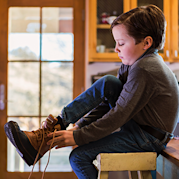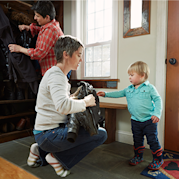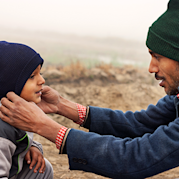What to do when kids refuse to put on certain clothing

By Gail Belsky
Expert reviewed by Mark J. Griffin, PhD
Quick tips when kids won’t wear certain clothes
- Quick tip 1Try more comfortable clothing.
 Try more comfortable clothing.
Try more comfortable clothing.Small changes can make a big difference. Look for softer fabrics, like fleece, and clothes with looser collars. Remove clothing tags. Or try a hooded sweatshirt rather than a coat.
- Quick tip 2Let kids choose.
 Let kids choose.
Let kids choose.When kids have a say in what they wear, it makes getting dressed go more smoothly. Give some basic rules (pants, long sleeves). With young kids, give just two or three options to make things simpler.
- Quick tip 3Do a trial run.
 Do a trial run.
Do a trial run.Get clothes ready the night before. Kids can try them on to make sure they’re comfortable — and pick out something else if they’re not.
- Quick tip 4Leave plenty of time.
 Leave plenty of time.
Leave plenty of time.Rushing kids into clothes can raise the stress level and set off an outburst. Give them extra time to put on clothes — and time to calm down if they’re getting upset.
- Quick tip 5Pick your battles.
 Pick your battles.
Pick your battles.It may not be worth it to argue or fight. On chilly days, that might mean giving up on the scarf and letting kids experience what it’s like to be cold. Facing natural consequences can help kids make better choices next time.
When kids refuse to put on certain clothes, it might seem like they’re just being difficult. But refusing clothing may not be about stubbornness. Some kids are so sensitive to how different types of clothing feel that they can’t tolerate wearing them.
When kids refuse to put on clothing — whatever the reason — it can be frustrating and get in the way of daily routines. It can also be hard to know what to do.
The good news is there are many ways to help, both in the moment and ahead of time. First, try not to show your own frustration. Adding more emotion to the situation is likely to make it worse. The key is to focus on solutions and to let kids know you’ll work with them on it.
When kids have extreme reactions to clothing, it can be very stressful for them. You can give them a small sense of control by waiting for a calm moment and then asking what they think might help. Kids often come up with ideas that work best because they’re the only ones who can really feel what’s bothering them.
Dive deeper
Why it happens
Some kids are highly sensitive to information that comes through the senses — smells, tastes, noise, light, and touch. They try to avoid the things they find intolerable. For some, that includes certain types of clothing, bedding, or other things their skin comes in contact with.
Learn more about sensory overload.
More ways to help
The best way to handle clothing refusal is to avoid what’s causing it. Find out exactly what types of clothing or aspects of clothes kids find intolerable. Is it itchy labels or seams? Heavy winter clothes? Pants with zippers and buttons?
Once you know what kids are reacting to, you can adjust or avoid clothes that are uncomfortable. If the trigger isn’t obvious, try observing the behavior more closely. You might pick up on patterns you never noticed before.
Next steps
When kids are oversensitive to the feel of clothing and other sensory “information,” it’s hard not to notice. But it may look different at home than at school.
Families and teachers should connect and share notes on what they see. They can work together to find strategies and supports that make it easier for kids to manage sensitivities.
Knowing what’s behind the challenges lets you give the right type of support. Pediatricians can help you find answers about what’s going on. They can also talk about therapies that might help, like occupational therapy.
Parents and caregivers: Get tips for talking with teachers about sensory challenges.
Educators: Learn about classroom supports for kids with sensory processing issues.

